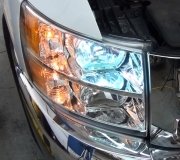The problem isn't the voltage; it's the current. AC generators, (alternators) put out three phase current, then rectify it to a steady DC to charge the battery. When one diode is bad you lose one entire phase. During times when the voltage from that phase is missing it goes down real low and the voltage regulator sees that and responds by making the generator work harder. That brings the voltage of the other two phases up higher. The battery smooths that out but the difference between the lowest voltage, when that phase is missing, and the highest voltage is the "ripple" voltage. That's why the voltage developed by the generator can be perfect, ... Between 13.75 and 14.75 volts, but the rated current can't be developed. If the guy used a small hand-held tester to put a load on the system, that will not give an accurate picture of whether the proper current can be developed. They just put a load on everything to draw the battery voltage down, then watch to see if the generator can pump it back up and maintain it at least to 13.75 volts. As for current, all you know is you have something. You don't know how much.
Professional load testers use an inductive pickup clamped around the generator's output wire. The unit draws current from the battery just like the portable units do but instead of watching the voltage, they measure how much current the generator can produce while still maintaining that minimum voltage. For a late '80s truck the typical generator will be rated at around 65 - 70 amps. With a bad diode it will only develop one third of that or around 20 amps.
Think of a three-piston water pump filling a municipal water tower. It may develop 100 pounds of pressure, (that equates to voltage which is electrical pressure), and lets say for this sad story it can pump 90 gallons per minute. Gallons per minute equates to current flow in amps. When one cylinder fails, some of the water from the other two cylinders fills that dead cylinder first, then whatever is left over goes out to the tower, (in this case the car battery). The two good cylinders can still develop 100 pounds of pressure but not until they fill the dead cylinder. Overall that means it can pump 30 gallons per minute into the tower; one third of its maximum rating, but the pressure will be normal. Measuring the water pressure won't show if the pump is working fully. Measuring system voltage at the battery will show if the generator is working but not if it's able to meet its maximum current rating.
I would feel better seeing the test done myself before telling you to replace the generator. If it can only develop 20 - 30 amps under a full load, it has to have a bad diode. The only alternator I've ever seen that was designed to only produce 35 amps was the standard unit available on my "80 Volare. That car has no air conditioning, no power locks or windows, and no electronic fuel injection or electric fuel pump, yet it came with a bigger unit as part of a trim package. It's rare to see a good alternator that is that small by design. (By the way, I used the term alternator there because Chrysler developed it and used it first on 1960 models and they copyrighted that term). Everyone else call theirs "AC generators". The point of the story is to only get 20 - 35 amps under a load test, it has to be a 35 amp generator that's good or a 65 - 70 amp generator with a bad diode, ... And there ain't many 35 amp generators out there.
You didn't tell me which generator you have. I'm guessing you have the newer design with the voltage regulator bolted to the back because that one will cause the flickering warning light. On older Ford charging systems the voltage regulator turned on the dash warning light when there was no output current from the generator. On the one with the regulator bolted to the back, it will also turn the warning light on for an under-charge condition and an overcharge condition.
If a load-test shows the generator can easily produce its maximum current yet the warning light is flickering, there is a way that can be caused by the generator itself but it would be WAY more likely to be caused by a problem in the voltage regulator. With the older system that is bolted to the fender and must be replaced separately. On the newer system it CAN be replaced separately but a new one will come with a replacement generator.
$169.00 seems awfully high if you have the older style with a separate voltage regulator. You can look them up on rockauto. Com to compare the pictures to what you have. Since both of these generators don't cause a real lot of problems you might want to consider getting a used one from a salvage yard. If you're anywhere between Ohio and southern Georgia, there's a real nice chain of yards called "Pull-A-Part". You pay your buck, throw your tool box in one of their wheel barrows, and you can spend all day there. I've been to 16 of their 23 yards and all were very clean and well-organized. Employees and customers are very friendly, and parts are REAL inexpensive. My list is a few years old but alternators are listed at $11.48, or $14.74 with a warranty. You can do an internet search to see how many trucks they have at each yard like yours.
Friday, March 22nd, 2013 AT 10:10 AM


